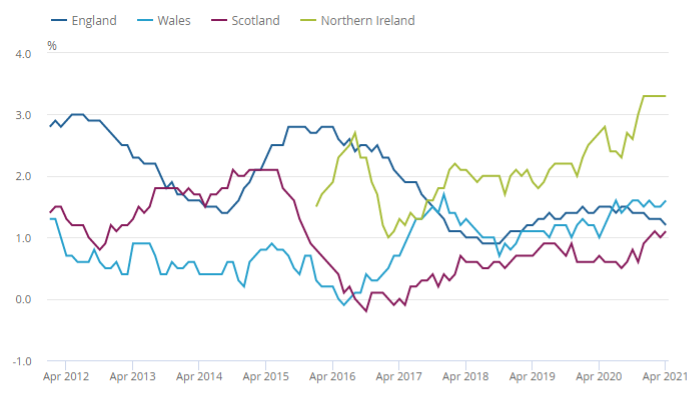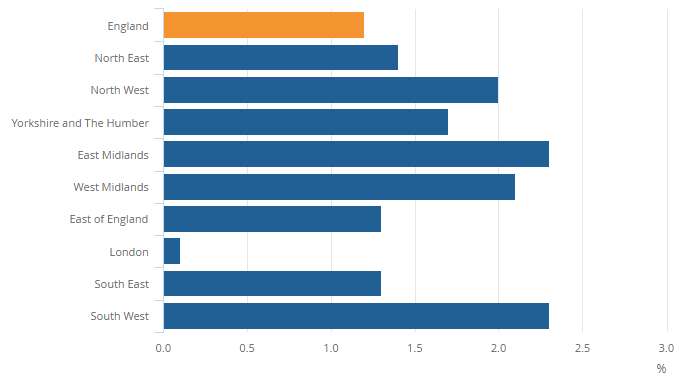Rents increases are continuing to plateau, according to the latest official data from the Office for National Statistics (ONS). Here we have our rent digest May 2021.
Rents have nudged up and down by just 0.1% since January 2020 when the 12-month increase was 1.5%.
In April, the latest month for data, the annual change was 1.2% a 0.1% fall on the figure for March.
Rents in Wales are rising the fastest – up 1.6% in the past year, compared to 1.2% in England and 1.1% in Scotland.
Rents excluding London grew by 1.8% year on year, while in the capital, tenants are paying just 0.1% more.
UK average rents have increased by 10.3% since January 2015, when the ONS started to record data.
Contents
Rent increases by country – April 2012 to April 2021

Source: ONS
Rents by region in England
Rents are growing the fastest in the South West and East Midlands, where landlords have increased prices by 2.3% – a slight fall from March.
Rents are climbing the lowest in London, where rents were up 0.1%, followed by the South East and East of England, both at 1.3%, says the March ONS Private Housing Rental Price Index
Thee ONS also points out that the Association of Residential Letting Agents (ARLA) and Royal Institution of Chartered Surveyors (RICS) report the number of tenants seeking a new home rose for the third month in a row, while the number of properties available to rent is falling.
Rent increases in England – year to April 2021

Source: ONS
Check median rents for your local authority for different property types with this interactive map.
Source: ONS
Tax and legal changes trigger surge in rents
Rents are set to rocket in the summer because the government fails to understand how the private rental market works, claims a leading property expert.
Andy Halstead, chief executive at tenant referencing firm Homelet blames rising rents on the cost of dealing with everchanging tax and legal changes rather than a greedy push for profits by landlords.
And he warns tenants are likely to pay more as COVID-19 restrictions relax.
The average rent paid by tenants across the UK is £996 a month – up 2.9% from May last year.
London rents are down 5.3% from May last year from £1,668 a month to £1,580.
“We’re fast approaching a summer where rental prices could accelerate at a rate never seen before,” he said.
“Almost a quarter of adults in the UK live in the private rented sector. The sector’s importance seems to be understated by those who don’t understand how vital it is.
“The common misconception is that increases in rents are solely driven by unscrupulous landlords trying to maximise profits. That is simply not true.”
“Landlords have been hit by a sustained raft of legislative changes, which mean that their costs to let property have had to increase. With the Tenant Fees Act as an example, costs are ultimately passed on to tenants through higher rents – the same group who should have benefited most from that legislation.
“The ban on all tenant evictions and plans to abolish Sections 21s may prompt some landlords to consider exiting the market, causing yet more strain on property supply. Letting property will continue to be an excellent long term investment, but the pandemic has amplified some of the issues that both landlords and tenants are facing.
“Once the furlough scheme ends, millions of people could potentially face unemployment at the same time as tackling the most expensive rental market on record. The country risks a deepening crisis if policy changes aimed at restoring balance to the market are not urgently pursued.”
Homelet – Average rents by region
| Region | Apr-21 | Apr-20 | Yearly change | Mar-21 | Monthly change |
| Greater London | £1,580 | £1,668 | -5.30% | £1,586 | -0.40% |
| South East | £1,102 | £1,043 | 5.70% | £1,086 | 1.50% |
| East Of England | £993 | £929 | 6.90% | £987 | 0.60% |
| South West | £955 | £879 | 8.60% | £936 | 2.00% |
| North West | £791 | £744 | 6.30% | £788 | 0.40% |
| West Midlands | £755 | £727 | 3.90% | £746 | 1.20% |
| East Midlands | £709 | £656 | 8.10% | £718 | -1.30% |
| Yorkshire & Humberside | £693 | £647 | 7.10% | £688 | 0.70% |
| Scotland | £689 | £665 | 3.60% | £682 | 1.00% |
| Wales | £686 | £646 | 6.20% | £677 | 1.30% |
| Northern Ireland | £670 | £663 | 1.10% | £681 | -1.60% |
| North East | £555 | £521 | 6.50% | £542 | 2.40% |
| UK | £996 | £968 | 2.90% | £992 | 0.40% |
| UK excluding Greater London | £853 | £803 | 6.20% | £847 | 0.70% |
Source: Homelet
Guild of Landlords Rent Digest – FAQ
For landlords confused by the stats and what they mean, here are some answers to the most asked questions about rents.
Why do the rent indices show different results?
Check the data carefully. Different indices cover different periods, and the samples vary between reports.
The ONS has the biggest sample, so should return the most reliable figures, but the time taken to collect and analyse the statistics often means the ONS data lags the rest of the sector.
ARLA derives insights from letting agents and provides what’s known in the trade as a sentiment survey rather than solid data.
Homelet statistics are based on customer data, which may not fully reflect the market.
Should landlords raise rents in line with the stats?
That’s a business decision for landlords. The rent statistics are an indication of how the market is moving but do not reflect demand from tenants and property standards in local neighbourhoods.
Don’t forget the data is historical, so gives a picture of what’s happened rather than what will happen.
Which rent index is the best?
That’s up to individual landlords. One index with a strong customer base in the same area as a landlord’s portfolio may align more closely with market rents for that neighbourhood, for instance.
Average data is not much good if you don’t have an average home and median rents will cover everything from a room in a shared house to a four-bedroom home.
Extra research with local letting agents is likely to give a better view of where a landlord should pitch a competitive rent and stop them from underselling.
Although several letting agents and property organisations publish regular rent statistics, many have been affected by the coronavirus lockdown that has their reports suspended or delayed.
More information
We have more investing in property information for England and Wales.




